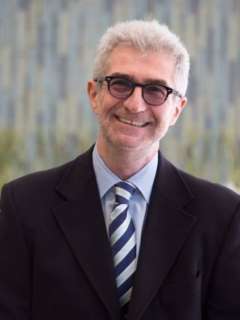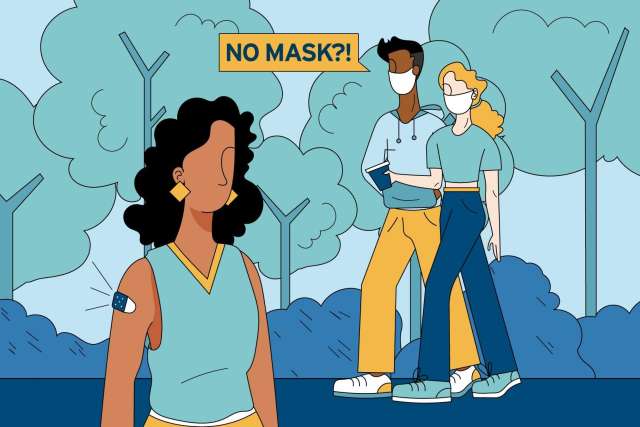After masking and social distancing for more than a year to slow the spread of COVID-19, new federal guidelines that say neither practice is necessary for people who are fully vaccinated may lead to a feeling of anxiety rather than liberation.
The U.S. Centers for Disease Control and Prevention announced May 13 that Americans who are fully vaccinated — defined as two weeks after receiving two doses of the Pfizer or Moderna vaccines or a single dose of the Johnson & Johnson shot — can forego masks and staying six feet away from others, except as required by state or local laws or regulations.
California’s mask rules — which require even fully vaccinated individuals to wear masks inside public places and at crowded outdoor gatherings — will remain in place until June 15.
Still, such a sudden relaxation of masking practices that have been considered key to protecting health during the past year of the pandemic can inspire anxiety and uncertainty, says Emanuel Maidenberg, PhD, clinical professor of psychiatry and biobehavioral sciences at the Jane and Terry Semel Institute for Neuroscience and Human Behavior at UCLA and the David Geffen School of Medicine at UCLA.
“From a public-health standpoint, it’s great news, because it suggests there’s enough data in the CDC scientists’ minds that vaccines are as effective as they’re supposed to be,” Dr. Maidenberg says. “However, the implication of it and the speed with which is was promoted to the level of ‘no masks altogether’ is a difficult one, I would imagine, for most people — certainly for people who became accustomed to using masks and social distancing, as it was urged and necessary, for a full year.”
Over the past year, many of us have made a cloth face covering one of the essentials we carry when leaving the house: keys, wallet, phone, mask. We heeded messages from health officials and covered our faces and kept our distance to protect our health and flatten the curve.
“In order to move in the direction the CDC allows now, we’ll have to override some of our automatic, habitual responses,” Dr. Maidenberg says. “It creates anxiety about the sudden change. It’s anxiety about the unknown” and what going mask-less might mean for our individual and collective health.
While mask-use recommendations have varied by state over the past year, California health officials mandated face coverings in June 2020 to curb the spread of aerosol droplets spread by exhaling, talking, coughing or sneezing that could carry coronavirus. Masks protect both the wearer and those around them from breathing in these airborne droplets.

More than 50% of Californians have received at least one dose of the COVID-19 vaccine and more than 39% are fully vaccinated, according to the Los Angeles Times. Nationwide, 47% of Americans have received at least one dose and 37% are fully vaccinated, the CDC reports. Children ages 12 to 15 are newly eligible for the Pfizer shot. The COVID-19 test-positivity rate in Los Angeles on May 17 was 0.4%, the lowest it’s been at any time during the pandemic.
All evidence points to waning risk. Yet, for many people, going out without a mask still feels strange – particularly since there’s no way to know if others have been vaccinated.
“Once we learn to be afraid of something, learning not to be afraid of it is quite a challenge,” Dr. Maidenberg says.
To get past the anxiety of shedding the mask, commit to the new behavior and start slowly, he says.
Dr. Maidenberg suggests establishing a practice of going outside without a mask for a brief period each day, while walking in the neighborhood, for example. “Even if I feel some anxiety or discomfort, I’ll remind myself what I know: that it’s quite a safe circumstance,” he says. “The important thing is to continue doing it on a consistent basis.”
Once walking outside bare-faced feels more comfortable, it will be easier to consider going inside a store or other public place mask-free, he says. Going mask-less indoors won’t be permitted statewide until June 15, so there’s time for Californians to get used to the idea.
Dr. Maidenberg notes that occasional breakthrough COVID-19 cases among fully vaccinated people are likely, but “our task is to practice a balanced response rather than catastrophizing and paying disproportionate attention to news that confirms the ‘looming’ threat.”
It’s not unusual to be apprehensive about such a change in health practices, he says, particularly when there has been so much legitimate fear around COVID-19. If normalcy is what we long for, however, we have to be prepared to eventually shed some of our pandemic protocols.
“The important thing is to start, versus not doing it and waiting longer,” Dr. Maidenberg says. “From the standpoint of public health, it’s better to start moving in that direction and relaxing these rules.”




